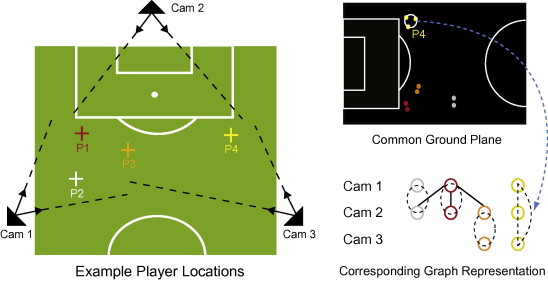A visualization framework for team sports captured using multiple static cameras
| Raffay Hamid | Ramkrishnan Kumar | Jessica Hodgins | Irfan Essa |
Computer Vision and Image Understanding (January 2014)

We present a novel approach for robust localization of multiple people observed using a set of static cameras. We use this location information to generate a visualization of the virtual offside line in soccer games. To compute the position of the offside line, we need to localize players’ positions, and identify their team roles. We solve the problem of fusing corresponding players’ positional information by finding minimum weight K-length cycles in a complete K-partite graph. Each partite of the graph corresponds to one of the K cameras, whereas each node of a partite encodes the position and appearance of a player observed from a particular camera. To find the minimum weight cycles in this graph, we use a dynamic programming based approach that varies over a continuum from maximally to minimally greedy in terms of the number of graph-paths explored at each iteration. We present proofs for the efficiency and performance bounds of our algorithms. Finally, we demonstrate the robustness of our framework by testing it on 82,000 frames of soccer footage captured over eight different illumination conditions, play types, and team attire. Our framework runs in near-real time, and processes video from 3 full HD cameras in about 0.4 s for each set of corresponding 3 frames.
Raffay Hamid, Ramkrishnan Kumar, Jessica Hodgins, Irfan Essa (January 2014). A visualization framework for team sports captured using multiple static cameras. Computer Vision and Image Understanding.
@article{Hodgins:2017:DOE,
author={Raffay Hamid, Ramkrishnan Kumar, Jessica Hodgins, Irfan Essa},
title={A visualization framework for team sports captured using multiple static cameras},
journal={Computer Vision and Image Understanding},
volume={118},
year={January 2014},

